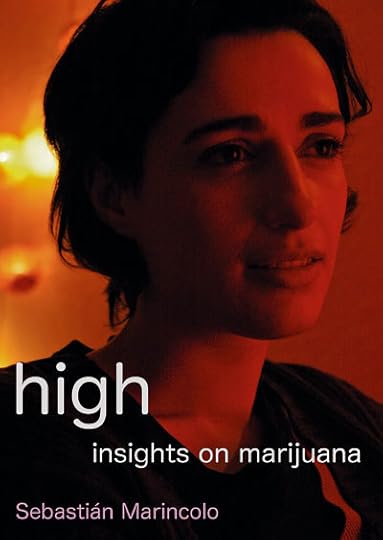Sebastian Marincolo's Blog: High Perspectives, page 5
November 26, 2015
New Book Release: “What Hashish Did To Walter Benjamin” available now!
“What Hashish Did To Walter Benjamin” is available in e-stores now! You can order the print version here.
Please share this post with whoever you think might be interested! Reviews welcomed!
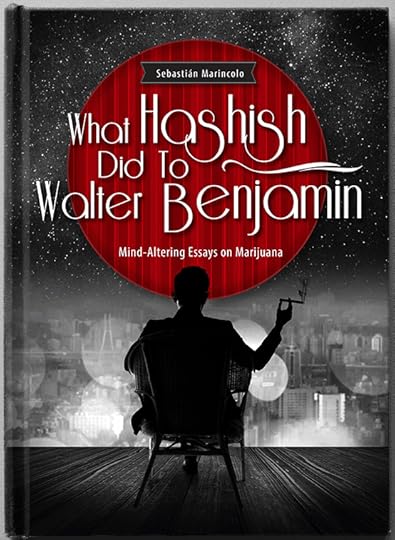 What is it like to be high on marijuana? Can a cannabis high help to remember long gone events, to fuel your imagination, to work creatively, to come to introspective and other insights, to empathically understand others, and to personally grow? How much did cannabis inspire outstanding thinkers, artists and musicians like Charles Baudelaire, Rudyard Kipling, Walter Benjamin, Billie Holiday, Diego Rivera, John Lennon, Carl Sagan, Hal Ashby, and so many others? And how much did the marijuana high positively transfom our society?
What is it like to be high on marijuana? Can a cannabis high help to remember long gone events, to fuel your imagination, to work creatively, to come to introspective and other insights, to empathically understand others, and to personally grow? How much did cannabis inspire outstanding thinkers, artists and musicians like Charles Baudelaire, Rudyard Kipling, Walter Benjamin, Billie Holiday, Diego Rivera, John Lennon, Carl Sagan, Hal Ashby, and so many others? And how much did the marijuana high positively transfom our society?
“What Hashish Did To Walter Benjamin – Mind-Altering Essays on Cannabis” is a collection of 20 groundbreaking neurophilosophically inspired essays on the astounding positive potential of the cannabis high. The essays summarize more than ten years of Marincolos research and are written for a wide audience. This deep new exploration of the marijuana high as an altered state of consiousness addresses educated marijuana users and their relatives, medical cannabis professionals and patients, as well as neuroscientists, psychologists, and philosophers interested in the subject of altered states of consciousness.
___
Praise
“Sebastian Marincolo’s work is terrific and is going to make a big contribution to the field.”
Lester Grinspoon, medical marijuana expert and Harvard Associate Prof. Emer. for Psychiatry
“Marincolo’s research on the marijuana high is years ahead of others working in this field”
Joe Dolce, former editor-in-chief of Details and Star magazines. He is writing a book, as yet untitled, about the new world of cannabis.
The post New Book Release: “What Hashish Did To Walter Benjamin” available now! appeared first on HIGH PERSPECTIVES.
November 17, 2015
Legalization Quote
“The legalization of marijuana is not a dangerous experiment – the prohibition is the experiment, and it has failed dramatically, with millions of victims all around the world.”
Sebastian Marincolo
The post Legalization Quote appeared first on HIGH PERSPECTIVES.
November 13, 2015
Insight Quote
“The movie Koyaanisqatsi shows non-commented time-lapse footage and focuses our attention on the very rhythm of our civilized modern life and nature. A marijuana high can do something for a user similar to what this time-lapse footage does. The enhancement of episodic memory and the acceleration of associative streams of memories can alter and enhance our recognition of patterns in our lives in various ways. If we are presented with quick associative chains of past experiences, we can see a pattern in a body of information that is usually not at once presented to our “inner eye” as such.”
Sebastian Marincolo
The post Insight Quote appeared first on HIGH PERSPECTIVES.
August 27, 2015
GUINEA – A Guerrilla-Neurophilosophical Approach to High Science
What is it like to be high? What is the positive potential of this altered state of consciousness for medical and inspirational uses? How exactly does marijuana enhance cognitive functions like our ability to remember episodes, our attention and perception or our ability to recognize patterns. Or to introspect bodily states, to empathically understand others and to generate new ideas and insights? How do the various cannabinoids and terpenes contribute to the high? Can we systematically research the high? And how important is research in this field?
The Positive Impact of the High on Individuals and Cultures Worldwide
According to U.N. estimates, cannabis is the most widely cultivated and used psychoactive substance worldwide. In recent years, it has become more and more evident that medical marijuana has a huge therapeutical potential for numerous indications and is used by many as a cognitive enhancer for inspirational and other purposes. Without doubt, we can also see a lot of abuse. Even though remarkably non-toxic, marijuana can certainly negatively affect the lives of consumers in various ways if abused. But many skilled users worldwide have discovered that a marijuana high can be an incredibly useful tool for many of their activities. We have innumerable reports from many cultures throughout history about how marijuana has helped individuals to work better creatively, to perceive all kinds of new patterns, to inspire them in their sexual relations, to come to introspective and other insights, to deepen their relationships with others and to personally grow, to name just a few of the enhancements reported. These enhancements have not only touched and transformed individual lives, but through these indviduals work, whole societies worldwide have witnessed the positive effects.
A concerted research effort of the marijuana high and its positive uses would give us a better picture of how cannabis use has actually influenced science, literature, art and other cultural developments worldwide.

Marijuana user Bob Marley
Innumerable inspirational and medical users would profit from knowing more about the exact cognitive alterations resulting from various strains. And, as I will argue here, researching the marijuana high may lead to important advances in our scientific understanding of the nature of mental processes like introspection, empathy or the generation of insights.
In recent years we have learned that marijuana strains with high ratios of CBD (cannabidiol) can give patients suffering from epilepsy an effective treatment without getting them too high, which is a blessing for many. However, we should not turn away too quickly from the “high” as something we consider solely as an unwanted side effect. Many users still seek a certain high and its respective mind-alterations; the high will always remain crucial for certain therapeutical, inspirational and other uses.
The ‘Gold Standard’ for Medical and Inspirational Use
The experience of medical marijuana patients so far has clearly shown us that natural strains of marijuana work a lot better than synthetic cannabinoid extracts or natural extracts of single cannabinoids like THC. I agree with medical expert Lester Grinspoon, who calls natural marijuana the “gold standard” for medical marijuana.
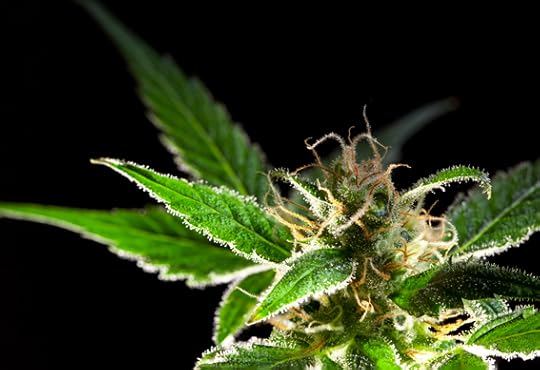
Jack Herer flower
We have to keep in mind then, that the various “highs” with their individual character valued by millions of users comes from natural strains with different cannabinoid and terpene and flavonoid profiles. Cannabis strains contain more than 80 different cannabinoids, approximately 120 different terpenes and more than 20 flavonoids. Therefore, we should obviously expect significant and interesting variations in the high coming from different strains. But how can we make serious progress when it comes to researching the ways in which various cannabis strains alter consciousness?
A New Approach to Researching the Marijuana High
In short, I would like to suggest GUINEA, a neurophilosophical approach to High Science. GUINEA is an unconventional integrative and interdisciplinary approach that comes in two phases. First, we need careful anecdotal data mining of reports from “guerrilla” users of marijuana. In other words, we need to critically analyze detailed reports of experienced marijuana users about their experiences with marijuana strains and each strain’s mind-altering potential. This approach is not new. Both Harvard scholars Charles Tart and Lester Grinspoon started such an approach more than 40 years ago. While Tart send a questionnaire about marijuana and its effects to 750 students and evaluated the feedback, Grinspoon collected reports from various literary and other resources. Tart’s and Grinspoon’s approach was based on the insight that set and setting significantly influence the high. Tart himself pointed out that the usual scientific method of observing subjects with no previous experience with marijuana in a laboratory setting just leads to anxiety and other reactions – reactions not caused by marijuana intake but by the sterile scientific setting. Another important fact which Lester Grinspoon and I have repeatedly stressed in the past is that much depends upon the skill of users to learn how to use marijuana and how to “ride a high” – just like surfers need to learn to use a surfboard to ride a wave.
Ideally then, scientists should analyze stories of skilled psychonauts if they want to find out about the psychoactive potential of a high. Traditionally, scientists would work with neophyte test persons when testing the effects of marijuana but, of course, they lack the knowledge to make use of the altered state of mind. More experienced users not only know how to use their strains for various enhancements given their own psychological make up and mood, they will also be able to introspect subtle nuances in cognitive changes brought about by various strains. A true wine taster needs vast knowledge about the nature of various grapes, soils, production and processing methods, as well as the storage of wines. The more he knows, the more he will be able to discriminate the nuances in his taste experience. For marijuana psychonauts, this kind of expert knowledge will be even more crucial. For them, the issue will not be mainly about taste experiences, but about a whole array of cognitive enhancements. The better their knowledge of psychology, the more they will be able to introspectively tell us in which ways a strain leads to various cognitive alterations in such complicated processes such as attention hyper focussing, pattern recognition or empathic understanding. Lester Grinspoon’s internet project “marijuana-uses.com”, which collects reports and essays from experienced users is a unique resource for this approach because it presents a fine selection of reports from skilled marijuana users with great psychonautic abilities.
As a result of the critical evaluation of skilled psychonautic user reports, we will be able to make hypotheses about the effects of marijuana strains on higher cognition. The formulation of those hypotheses involves not only experiential reports, but will include state of the art knowledge of various cognitive science disciplines. In the second phase of GUINEA, these hypotheses should be taken to empirical testing. In my previous book High. Insights on Marijuana, I have generated various hypotheses based on the analysis of anecdotal reports from skilled marijuana users which should be further taken to scientific testing, including the hypotheses that a marijuana high leads to certain changes and enhancements in bodily perception, introspection, empathic understanding, pattern recognition and to an enhanced ability to generate insights.
GUINEA is not only an interdisciplinary scientific approach, but also a cross-field one, meaning that we not only need to include knowledge from scientific disciplines such as the philosophy of mind, the neurosciences, psychology and other cognitive sciences, but also from other cultural and sub-cultural fields, such as the legal and Guerrilla cannabis growing scene or from shamanic and other cultures with experience of cannabis. Let us first look at the interdisciplinary scientific fields of knowledge involved.
Neurophilosophy and the High
If we want to understand how a marijuana high affects higher cognitive processes and abilities like episodic memory retrieval, introspection or spontaneous insights we will have to turn to neurophilosophy – a modern interdisciplinary approach of various mind sciences. For instance, let’s look at the question of whether a high can enhance empathic understanding. How does empathic understanding work, in general? In the last 20 years, there were heated debates in the philosophy of the mind and in psychology. After the groundbreaking work on conceptual analysis by philosophers, scientists focused their attention on neuroscientists who claimed to have found a specialized neuronal system – the mirror neuron system – underlying our capacity to feel with others and to understand them. The debate concerning empathy has led to fundamental advances in our understanding of the nature of empathy, which is extremely valuable when it comes to the understanding of pathological states such as autism or psychopathic behaviors.
Of course, many questions remain debated in this field. What is the exact role of the mirror neuron system? Autistic children have strong deficiencies in their empathic understanding; are these related to an underdeveloped mirror neuron? Which cognitive abilities are involved in empathic understanding? It is important to see that these debates are still ongoing; the study of empathy today is a common interdisciplinary effort in which philosophers of the mind, neuroscientists, cognitive scientists, evolutionary biologists, developmental psychologists and many others are discussing new findings to integrate them into a unified picture of empathy. Likewise, whole arrays of researchers from various areas discuss other mental abilities, such as introspection or spontaneous insights. We have a myriad of reports that a marijuana high affects many of these complex mental abilities. Consequently, researching the high demands a similar interdisciplinary approach.
The Endocannabinoid System (ECS)
The most promising approach to researching the high within the neurosciences was certainly the discovery of one of the major physiological systems in our brain and body, the endocannabinoid system in the beginning of the 1990s. Interestingly, this system is found not only in humans but is also common to other vertebrate animals and can even be found in some invertebrate animals, which shows its importance in the process of evolution. As we now know, the effects of cannabis on both body and mind come because the cannabinoids from the plant are similar to those produced endogenously by our own brains. So, we all have a signaling system that involves endocannabinoids (anandamide and 2-AG) and endocannabinoid receptors (CB-1 and CB-2) involved in the regulation of various processes. The endocannabinoid system (ECS) is involved in the regulation of many bodily and mental processes including stress response, appetite, immune function, pain, sleep and memory.
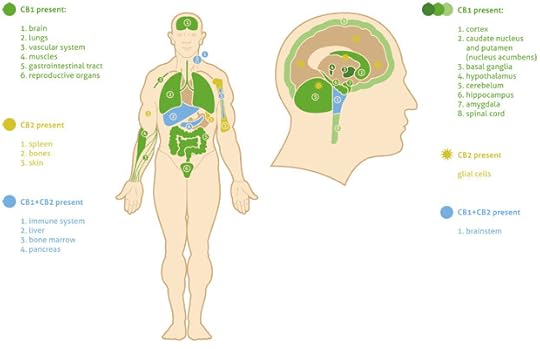
Distribution of the CB-1 and CB-2 receptors of the endocannabinoid system. Taken from http://www.fundacion-canna.es/sites/d...
New findings concerning the ECS in the last 20 years have to a large degree explained many anecdotes about positive medical marijuana uses and inspirational uses. To name one well known example, we now know that the endocannabinoid system also controls appetite; when consumed phytocannabinoids (from the cannabis plant) interfere with this signaling system, it may be stimulated to give you the “munchies”, an effect that has been consistently reported by marijuana users for centuries. I will not go into the details of our knowledge of the ECS here. Let me just point out that although we already know about many of the functions of the incredibly versatile and important ECS in our brain, I believe that we are still at the beginning when it comes to understanding its role in various higher cognitive processes. Scientists investigating the ECS should definitely look into the details of marijuana user reports about the mind-altering potential as a guide to find more functions of the ECS in cognition.
Various Brain Imaging Techniques
Once we have generated scientific hypothesis based on critically evaluated anecdotal reports, we can start to design experiments with volunteers being subjected to brain scanning during a high. New imaging techniques like functional magnetic resonance imaging (fMRI), computer tomography (CT) or Positron Emission Tomography (PET) could augment our understanding how the high affects various cognitive abilities such as pattern recognition, creativity, empathy. or introspection. Such practices could actually inform the neurosciences about possible functions of the endocannabinoid system and its functional relations to other neuronal systems. Obviously, we first need to have experiential reports of marijuana users about the cognitive effects of a high to know what we are looking for and to start constructing experiments.
Other Fields of Knowledge
The “neurophilosophical approach” to the study of the marijuana high will include just as many scientific disciplines as the general mind sciences studied today – evolutionary biology and psychology, a whole range of cognitive science disciplines, linguistics but also, for instance, an ethno-botanological perspective as can be found in the work of Ronald Siegel, with his groundbreaking research on the interaction between animals and psychoactive plants. Also, scientists need to understand that there is much relevant knowledge coming from various cannabis cultures and subcultures that have evolved over thousands of years. Scientists researching the marijuana high should be interested in guerrilla marijuana breeder’s cannabis wisdom, shamanic knowledge, as well as looking at what professional agricultural cannabis engineers have to say about their marijuana strains. This is why I emphasize that the approach to researching the marijuana high should not only be scientifically “inter-disciplinary,” but also “cross-field”. Shamanic wisdom, the knowledge of cannabis breeders and anecdotal reports of skilled ‘guerrilla’ cannabis users as those collected by Grinspoon are usually not considered to be anything that should even enter the realms of science; but I believe it should actually be taken very seriously. A careful analysis of these fields of knowledge would help to lead the way for other scientists to come up with new hypothesis and experiments to investigate the nature of a cannabis high.
Philosophers, Neuroscientists, and Shamans
So far, there are no significant budgets for a concerted research program of the marijuana high. Governments worldwide have been heavily influenced by various interest groups to hinder the research of one of the most promising plants ever known to man. Presumably, an independently operating foundation would be a better place to look for the necessary open-mindedness and empathy for the millions of people who would profit from an interdisciplinary research center using GUINEA. It would be an unconventional decision to investigate the positive potential of the high – which is already outrageous to many. Supporters would also have to understand that our path into the natural and fascinating jungle of the altered human mind cannot be an autobahn made of concrete that we brutally build into this jungle. Many empirical studies with neophyte study participants taking a psychoactive substance for the first time have been so destructively intrusive in their whole setup that they show us more about the participants’ reactions to their environment than about the effects of the respective psychoactive substance. The guerrilla-neurophilosophical approach of GUINEA would acknowledge the value of wisdom, not only of experienced guerrilla marijuana users but also of guerrilla breeders, shamans and other cannabis subcultures worldwide.
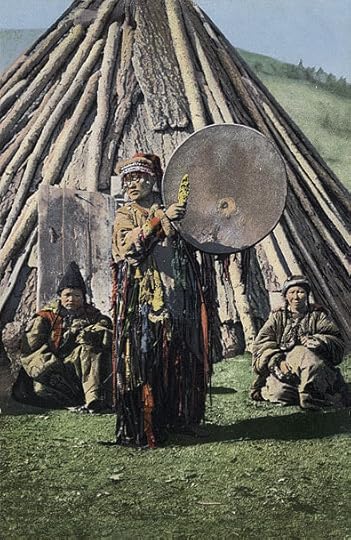
Altay Shaman with drum.
Importantly, this research project as a whole will not only help us to better understand what is going on when we get high and to understand the medical and inspirational potential of cannabis. It will also help us to find out more about the nature of human consciousness itself. Readers of Oliver Sacks’ books should be well familiar with this approach. Sack’s detailed anecdotes about his patients with neurological disorders or syndromes such as Tourette’s syndrome do not only tell us much about the nature of respective pathological conditions, they help us to come to a new understanding of the nature of the human mind itself.
The systematic changes of various cognitive processes such as, for instance, our empathic understanding during a marijuana high could be extremely interesting for researchers in their respective fields, leading to a better understanding of the functional architecture of those states themselves. This is an important lesson – a cross-field neurophilosophical study of the marijuana high (or altered states in general) will not only help us to understand the altered state of mind of the high better, but also help us to understand the nature of most complex abilities of the human mind, like introspection, empathy, creativity and the ability to generate spontaneous insights.
To conclude, then, here is my recommendation for how to research the marijuana high: philosophers, cognitive scientists, psychologists, biologists, anthropologists, neuroscientists and others, research the high. Don’t be shy. Work together. And don’t be snobs. Guerrilla users, urban guerrilla growers, tribal shamans, or Indian sadhus may know a lot more than you imagine.
****
This essay will be included in my new book “What Hashish Did To Walter Benjamin”. You can help me self-publish the book by contributing to my Indiegogo crowdfunding campaign: http://igg.me/at/what-hashish-did-to-...
Compare Ellen Komp’s http://www.veryimportantpotheads.com/ for a list of influential marijuana users and a description of their respective uses.
For an excellent essay on this subject see Malmo-Levine, David (2009) „Patented Pot versus The Herbal Gold Standard“, http://www.cannabisculture.com/node/1...
Tart, Charles T. (1971). On Being Stoned: A Psychological Study of Marijuana Intoxication. Palo Alto, Cal.: Science and Behavior Books, and Grinspoon, Lester (1971). Marihuana Reconsidered. Cambridge, M.A. Harvard University Press.
Compare my essay http://sensiseeds.com/en/blog/marijuana-surfing-and-riding-a-marijuana-high/ A more detailed version is in my Marincolo, Sebastian (2013) High. Das positive Potential von Marijuana, Klett-Cotta/Tropen, Stuttgart (in German).
Marincolo, Sebastián (2010), High. Insights on Marijuana. Dog Ear Publishing, Indiana.
See Siegel, Ronald K. (1989, 2005), Intoxication. The Universal Drive for Mind-Altering Substances. Park Street Press, Rochester Vermont.
Compare for instance Sacks, Oliver (1986). The Man Who Mistook his Wife for a Hat. London:Picador.
See my essay “Marijuana, Empathy, and Cases of Severe Autism”
The post GUINEA – A Guerrilla-Neurophilosophical Approach to High Science appeared first on HIGH PERSPECTIVES.
July 15, 2015
Indiegogo Campaign For My New Book Now Online!
To all my blog readers:
I have just started an Indiegogo crowdfunding project for my new book “What Hashish Did To Walter Benjamin”. The book will contain 20 of my essays (some of which are already featured here on this blog). If you like the project, please support me on Indiegogo, http://igg.me/at/what-hashish-did-to-walter-benjamin
You can also help me spread the word by sharing the following text on your facebook page:
Worldwide, people are beginning to acknowledge the positive potential of cannabis. Philosopher and writer Sebastian Marincolo has written a new book “What Hashish Did To Walter Benjamin” in which he explains how a cannabis high can help to remember long gone events, to fuel your imagination, to work creatively, to come to insights, and to better empathically understand others. His book also sheds light on how cannabis has helped writers, philosophers, musicians, and artists like Walter Benjamin, Carl Sagan, or Billie Holiday in their work. Help him spread the word and support his Indiegogo campaign: http://igg.me/at/what-hashish-did-to-walter-benjamin
It is time that we make a difference and take this to the next level together! Thank you so much in advance for your support!
Yours, Sebastian Marincolo
The post Indiegogo Campaign For My New Book Now Online! appeared first on HIGH PERSPECTIVES.
July 2, 2015
Carl Sagan, Cannabis, and The Right Brain Hemisphere
„What it comes down to is that modern society discriminates against the right hemisphere.“
Roger Wolcott Sperry (1913-1994), neuropsychologist and neurobiologist, known for his revolutionary studies of split brain patients
In 1971, Harvard Prof. Lester Grinspoon published his milestone book „Marijuana Reconsidered“, in which he featured an essay “Mr. X” by his best friend, the famous astronomer and science popularizer Carl Sagan. In his essay, Sagan reports that for him, the marijuana high led to various cognitive enhancements, including the enhancement of cognitive abilities like enhanced episodic memory, pattern recognition, creativity, and the ability to produce insights. More than forty years later, Sagan’s essay “Mr. X” is still one of the most illuminating accounts on the positive mind-altering potential of the marijuana high. Many other cannabis users before and after Sagan have described similar mind enhancements during a high. My own experiences with the marijuana high had been very similar, and my research aims to explain how good quality marijuana can induce insights and many other cognitive enhancements, given that it is used by skilled users.
Sagan’s Hypothesis
Sagan was so excited about the cognitive enhancements he experienced with marijuana that he used it on a regular basis to come to insights for his work. His biographer Keay Davidson wrote that when Lester Grinspoon received unusual high-quality marijuana from an admirer by mail, he shared the joints with his friend Sagan and his wife Ann Druyan. “Afterward, Sagan said, ‘Lester, I know you have only got one left, but could I have it? I’ve got serious work to do tomorrow and I could really use it.”

Carl Sagan, American astronomer and popularizer of science (1934-96)
Sagan was famous – or, for many of his academic colleagues, infamous – for making brilliant but daring speculations – not only in his field of astronomy, but also in other scientific fields. As his biographer Davidson remarks, Sagan for instance wrongly predicted the existence of complex organic molecules on the moon; but, Davidson adds, “(a)s it turned out later, complex organic molecules pervade much of the outer solar system and beyond.”
In his Pulitzer price-winning book “The Dragons of Eden – Speculations on the Evolution of Human Intelligence”(1977), Sagan summarized what cognitive and evolutionary scientists had to say about the evolution of the human mind and presented many of his own brilliant speculative ideas on the nature and evolution of human intelligence. He also introduced a speculative thesis about the effects of marijuana on the human brain. Sagan started from an analogy made by psychologist Robert Ornstein:
“He {Ornstein} suggests that our awareness of right hemisphere function is a little like our ability to see stars in the daytime. The sun is so bright that the stars are invisible, despite the fact that they are just as present as they are in the daytime as at night. When the sun sets, we are able to perceive the stars. In the same way, the brilliance of our most recent evolutionary accretion, the verbal abilities of the left hemisphere, obscures our awareness of the functions of the intuitive right hemisphere, which in our ancestor must have been the principal means of perceiving the world.”
In a now famous footnote to this paragraph Sagan formulates his hypothesis on how a marijuana high could affect thinking:
“Marijuana is often described as improving our appreciation of and abilities in music, dance, art, pattern and sign recognition and our sensitivity to nonverbal communication. To the best of my knowledge, it is never reported as improving our ability to read and comprehend Ludwig Wittgenstein or Immanuel Kant; to calculate the stresses of bridges; or to compute Laplace transformation. (…) I wonder if, rather than enhancing anything, the cannabinols (the active ingredient in marijuana) simply suppress the left hemisphere and permit the stars to come out. This may also be the objective of the meditative states of many Oriental regions.”
Enhancements and Suppression
Let me distinguish two aspects of Sagan’s hypothesis: First, there is his observation that a marijuana high leads to a style of thinking which cognitive scientists consider to be predominantly based in the right hemisphere. Second, Sagan speculates that a marijuana high might suppress left hemisphere functions and, therefore, leads to what we could call “right hemisphere thinking”. Sagan’s hypothesis was based on his knowledge of what current science had to say about the human brain and the different style of cognition in the left and right brain hemispheres, as well as on his own experiences with marijuana.
Sagan’s Claim Reconsidered
During his lifetime, Sagan did not reveal to the public that he was a user of marijuana. In isolation, Sagan’s footnote about marijuana and its possible effect on the brain hemispheres may seem to be a spontaneous speculation out of nowhere. Yet, when reading Sagan’s essay “Mr. X”, it becomes clear that Sagan’s experiential basis for such a claim was actually quite broad. In his essay, he describes in some detail not only the enhancements outlined in his footnote, but he also mentions other cognitive enhancements, such an enhanced ability to remember past events and to obtain deep insights. Also, Sagan mentions that during a high, he also experienced enhanced
”perceptions of real people, a vastly enhanced sensitivity to facial expressions, intonations, and a choice of words which sometimes yields a rapport so close it’s as if two people are reading each other’s minds.”
Sagan already knew that most of the cognitive enhancements he had experienced during a high concern functions which cognitive science at the time found to be predominantly located in the right brain hemisphere; he had described the research concerning split brain patients and more on the pages preceding his hypothesis in “The Dragons of Eden”.
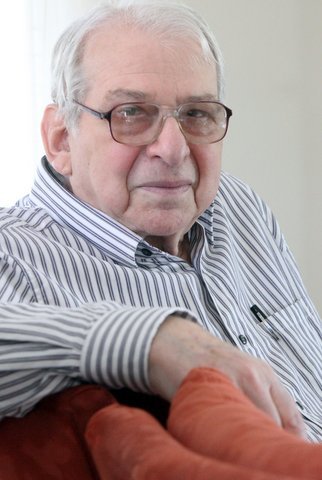
Dr. Lester Grinspoon, Assoc. Prof. Emeritus for Psychiatry at Harvard Medical School
Lester Grinspoon
So, Sagan knew this research and had made his own experiences with cognitive enhancements during a marijuana high. Furthermore, he was also well acquainted with his friend Lester Grinspoon’s research about marijuana as a medicine and about the mind-enhancing potential of marijuana. As Lester Grinspoon told me in private conversation, Carl Sagan had carefully read and commented upon his manuscript of “Marijuana Reconsidered”, in which Grinspoon extensively featured reports of other marijuana or hashish users who had described similar mind enhancements.
To summarize, then, Sagan’s hypothesis certainly didn’t come out of nowhere. Quite on the contrary, his knowledge about the differences in right and left hemisphere cognition style was quite impressive, and he knew a lot about the altered style of cognition during a high from his own experiences and from countless user’s reports he knew from Grinspoon’s work.
Now, what can we say about Sagan’s hypothesis almost 40 years later, with all the progress in the mind sciences on the nature of cognition in the respective brain hemispheres and with our knowledge about the endocannabinoid system and its many functions in cognition? Was Sagan on the right track?
Tragically, Sagan died in 1996, too early to witness the revolutionary discovery of the endocannabinoid system which started around that time. Since then, we have learned about the amazing range of its physiological and cognitive functions. So, can we actually find evidence for or against Sagan’s hypothesis for instance looking at the distribution of endocannabinoid recepors (especially the CB-1 receptor, on which the exogenous THC acts)?
Sagan’s Thesis and the Endocannabinoid System
As far as I can see, there does not seem to be extensive research concerning the subject of lateralization and the role of endocannabinoid signaling for higher cognitive functions. One often cited study found an increased blood flow in parts of the right hemisphere during a high, but another study states that “relatively high concentrations of cannabinoid receptors were consistently seen in cortical regions of the left (dominant) hemisphere, known to be associated with verbal language functions.“
It seems much too early to draw conclusions from brain imaging studies to evaluate Sagan’s hypothesis. Even better data on the concentrations of endocannabinoid receptors in the respective brain hemispheres will not directly lead to resolving the issue; Marsicano and Kuhner remind us that „sometimes the endocannabinoid system appears to be functionally important in regions or cell types where the density of CB1 receptor is relatively low {e.g. control of pain perceptions in the brainstem}.” As far as I can see, we haven’t yet begun to understand how the endocannbinoids are involved in affecting different higher cognitive functions based in the left or right brain hemisphere.
Recent Neuroscience and Reports about the Marijuana High
Some more support for Sagan’s thesis seems to come from two other sources. First, Sagan’s description of the cognitive enhancements during a marijuana high have been described in detail by many more cannabis users. The most impressive collection of recent anecdotal reports and essays about those enhancements comes from Sagan’s best friend Lester Grinspoon and can be found on his website marijuana-uses.com. Many of the enhancements reported by marijuana users seem to be based on a shift towards a more right-hemisphere cognition style during a high.
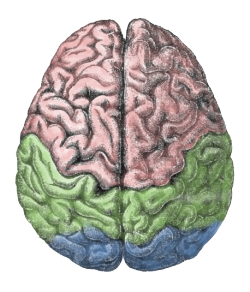
The left and the right brain hemisphere. They are anatomically similar, but different, and ongoing cognitive science is still being done to find out which cognitive functions are dominated by one side or the other.
Second, if we look at what recent neuroscience has to say about differences in the cognitive functions and processing styles in the two brain hemispheres, Sagan still seems to have a point. From what we know now, the right hemisphere plays an important role for the cognitive processes named by Carl Sagan as enhanced during a high, as well as for many other enhancements described by other marijuana users. In his book The Master and his Emissary. The Divided Brain and the Making of the Modern World, (2009), psychiatrist Ian McGilchrist gives a survey of the current scientific knowledge about the different styles of cognition in the left and the right brain hemisphere emerging from stroke cases in one hemisphere, split brain patient cases, and newer brain imaging studies. According to McGilchrist, the right hemisphere is predominately involved in our ability to remember personal events (episodic memory), is responsible for associations between widely different concepts and ideas, complex pattern recognition, creative problem solving, insights, the appreciation of humor, the understanding of metaphors, self-awareness, the empathic understanding of others, the processing of words describing the mind, and the interpretation of emotional expression in faces, in intonation and verbal implications. Also, the right hemisphere seems to be crucially involved in the interpretation of non-verbal communication and the perception of music. For the sake of brevity, I will leave it at this incomplete list, but actually, McGilchrist describes more cognitive functions as right hemisphere based, functions which all have been consistently reported by countless users to be enhanced during a high.
The Effects of Marijuana on Attention

“Romeo and Juliet”, painting by Frank Dicksee
In general, then, it seems that research of the last forty years in the neurosciences lend some more support Sagan’s thesis that marijuana leads to an enhancement of right hemisphere-based cognitive abilities. One interesting puzzle, though, is one of the fundamental effects of marijuana on attention. During a marijuana high, we seem to ‘hyperfocus’. High users often get completely absorbed by the taste of ice-cream, by an intense stream of memories or ideas, or by the sensation of a kiss.
In other words, a high seems to cause a strong selective focus on whatever we attend to. According to McGilchrist, however, focussed attention is not a cognitive function performed primarily in the right hemisphere. Quite on the contrary, he summarizes the current research as saying that “(…) the right hemisphere is responsible for every type of attention except focused attention.”
Evaluating Sagan’s Hypothesis
So, when it comes to attention, at least one of the typical cognitive changes during a high does not seem to come from an enhancement of processes in the right hemisphere. Generally, then, while Sagan seems to have been basically on the right track with his hypothesis, not all of the cognitive enhanced functions during a high seem to be predominately based in right hemisphere activities. We will have to wait for more research to be done in this field to see how exactly cannabis affects cognitive activities in the left and right brain hemisphere.
What about Sagan’s hypothesis that a high could suppress left hemisphere function and, thus, ‘bring out the stars’ and allow for an enhanced right hemisphere activity? As far as I can see, we are far from being able to tell whether the mind enhancements during a high observed by so many users come from a direct enhancement of certain cognitive functions, or whether they arise from a suppression of some left hemisphere activities.
 According to McGilchrist, the left and the right hemisphere are in a constant battle for control. In order to help us to survive, we and other animals need two conflicting systems of attention. He explains this point with the example of birds: to pick up seeds for food, a bird needs to narrowly focus on the seeds on the ground to motor control and coordinate food intake (left hemisphere function); but in order to survive, the bird has to get distracted by a predator like a fox or a falcon in the fringe of its perception. So there must be another type of attention drawing it to unusual new sensations (right hemisphere). Only the interplay of these competing attention systems located in the two brain hemispheres allows birds and other animals like us to survive. Clearly, then, an enhancement of cognitive processes in one hemisphere could come from the suppression or weakening of cognitive functions in the other hemisphere.
According to McGilchrist, the left and the right hemisphere are in a constant battle for control. In order to help us to survive, we and other animals need two conflicting systems of attention. He explains this point with the example of birds: to pick up seeds for food, a bird needs to narrowly focus on the seeds on the ground to motor control and coordinate food intake (left hemisphere function); but in order to survive, the bird has to get distracted by a predator like a fox or a falcon in the fringe of its perception. So there must be another type of attention drawing it to unusual new sensations (right hemisphere). Only the interplay of these competing attention systems located in the two brain hemispheres allows birds and other animals like us to survive. Clearly, then, an enhancement of cognitive processes in one hemisphere could come from the suppression or weakening of cognitive functions in the other hemisphere.
We still have to await further research to come to a better understanding on how consumed cannabinoids affect the endocannabinoid system and, generally, its role in higher cognition. Yet, almost forty years after Sagan’s hypothesis, I think we can still say that he was on an interesting track. As far as I can see, we will only come to a better understanding of the nature of the high and its effects on attention, memory, pattern recognition, creativity, empathy, or insights, once we are beginning to research how endocannabinoids and consumed marijuana affects various cognitive processes in the left and the right brain hemisphere.
A Historical-Sociological Perspective
Sagan’s hypothesis does not only have interesting implications for individual marijuana users. In his book The Master and his Emissary. The Divided Brain and the Making of the Modern World, Ian McGilchrist argues in detail that in various periods of history there were general shifts in our (Western) society toward more left or right hemisphere cognition styles which can be detected in art, science, philosophy, literature and politics:
“My thesis is that for us as human beings there are two fundamentally opposed realities, two different modes of experience; that each is of ultimate importance in bringing about the recognizably human world; and that their difference is rooted in the bihemispheric structure of the brain. It follows that the hemispheres need to co-operate, but I believe that they are in fact involved in a sort of power struggle, and that this explains many aspects of contemporary Western culture. (…) I believe that over time (…) the balance of power has shifted where it cannot afford to go – further and further towards the part-world created by the left hemisphere.”
For McGilchrist, this means that in our society we now predominatently rely on left hemispheric thinking; which leans towards abstraction, is more rational, mechanistic, less empathic, less open to the richfulness of holistic experience, and “yields clarity and power to manipulate things that are known, fixed, static, isolated, decontextualized, explicit, disembodied, general in nature, but ultimately lifeless.”
The right hemisphere, by contrast, represents the world to us as “individual, changing, evolving, interconnected, implicit, incarnate, living beings within the context of the lived world, but in the nature of things never fully graspable, always imperfectly known – and to this world it exists in a relationship of care.”
Just like Sagan, McGilchrist does not simply speak in favor of right hemisphere thinking, but reminds us that sane human cognition comes out of a balanced interplay between the two hemispheres. If McGilchrist is right, then what we dramatically need in our society is to come back from our imbalanced left-hemispheric thinking by using mindfulness or other techniques like meditation. If Sagan is right with his general hypothesis that a marijuana high actually does cause a more right-hemisperic style of thinking, then it is easy to see how skilled and knowledgeable marijuana use in our society could lead to positive changes in the mindset and thinking of our society as a whole. If we look back in recent history, we have already seen these changes happening and leading to vastly important positive cultural changes, from the early evolution of jazz to the peace movement of the beat generation. From this perspective, more widespread marijuana use might as well play an defining role in the elementary changes in our society yet to come; changes which could possibly help to save the world we live in.
Carl Sagan, „Mr. X“, in: Lester Grinspoon (1971), „Marijuana Reconsidered“, Harvard University Press, Cambridge, Massachussetts, p. 123 – 130. Sagan’s essay was published anonymously, Grinspoon revealed the identity of his author only years after Sagan’s untimely death.
See Sebastian Marincolo (2010), „High. Insights on Marijuana“, Dogear Publishing Indianapolis, Indiana.
Keay Davidson, (1999), „Carl Sagan. A Life.“, John Wiley & Sons, Inc., New York, p. 214.
Ibid., p. 213.
Carl Sagan (1977) „The Dragons of Eden. Speculations on the Evolution of Human Intelligence“, Random House Publishing Group, New York, p. 177
Ibid.
Carl Sagan, „Mr. X“, in: Lester Grinspoon (1971), „Marijuana Reconsidered“, Harvard University Press, Cambridge, Massachussetts, p. 127.
Roy Mathew et al. (1997) , „Marijuana intoxication and brain activation in marijuana smokers“, Life Sci. 1997;60(23):2075-89.
Glass, M., Dragunov, M., Faull, RL (1997) „Cannabinoid receptors in the human brain: a detailed anatomical and quantitative autoradiographic study in the fetal, neonatal and adult human brain.“ Neuroscience. 1997 Mar; 77(2): p. 299-318.
Marsicano, G., and Kuner, R. (2008), „Distribution of CB1 Cannabinoid Receptors in the Nervous System“, in: Attila Köfalfi (ed.) (2008), „Cannabinoids and the Brain“, Springer Science and Business Media, New York, p. 164.
Compare Sebastián Marincolo (2010), „High. Insights on Marijuana“, Dogear Publishing Indianapolis, Indiana.
McGilchrist, Ian (2009), „The Master and His Emissary, The Divided Brain and the Making of the Modern World“, Yale University Press, New Haven and London, p. 39.
Ibid, p. 3.
Ibid, p. 6.
Ibid, p. 174.
Ibid, p. 174.
Margaret Emory (2012) „Dr. Ian McGilchrist on the Divided Brain, Q&A with Ian McGilchrist“, BrainWorld, May, 8 2012, http://brainworldmagazine.com/what-at...
The post Carl Sagan, Cannabis, and The Right Brain Hemisphere appeared first on HIGH PERSPECTIVES.
June 25, 2015
Marijuana and the Enhancement of Episodic Memory
„A memory is a beautiful thing, it’s almost a desire that you miss.“
Gustave Flaubert, French writer (1821-1880)
Our memory is simply amazing. We can store information about thousands of situations but also abstract knowledge, theories, learned routines as well as practical skills like ice-skating or driving a car. Our memory keeps relevant information poised to meet our daily needs and plans, enables us to recognize people and places and facilitates remembering past events. With its various functions, memory constitutes the cognitive basis for our personal identity, for our decision-making, our present actions, and our attitude towards the future. Our memory defines who we are. Memory is everything.
Short-Term Memory Disruptions
When it comes to marijuana and its acute effect on memory during a high, many people think only of the infamous disruptions of our short-term (or “working space“) memory during a high. The effect is nicely described in Jack Margolis’ and Richard Chlorfene’s book “A Child’s Garden of Grass“ in a short conversation of two very stoned consumers:
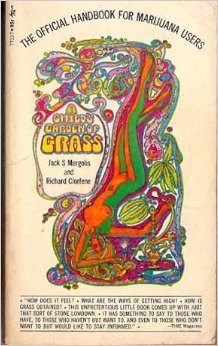
A Child’s Garden of Grass, by Jack Margolis and Richard Clorfene
Virginia: Are you hungry?
Andy: No. (Long reflective pause). Wait a minute. Did you mean am I hungry for food, or am I hungry in the abstract, like hungry for knowledge or adventure?
Virginia: What were we talking about?
Andy: You asked if I were hungry.
Virginia: Did I?
Andy: Yes.
Virginia: Well, are you?
Andy: Am I what?
When using various kinds of marijuana it is fascinating to see how much this disruptive effect on short-term memory depends not only on the dosage used but also on the type of marijuana and the route of administration. A freshly harvested and well fermented strain with higher levels of the terpene pinene consumed with a vaporizer may bring almost no such disruptions and experienced users often enjoy its high for hours of discussion or other activities without experiencing short-term memory problems.
Enhancement of Episodic Memory Retrieval
On the other hand, many marijuana users have consistently reported an enhancement of what cognitive scientists have called “episodic memory” or “autobiographical memory”. From these reports we know that during a high, users can often retrieve long-forgotten episodes of their lives, or have a much more vivid recollection of past events than usual. According to Yawger, the philosopher John Stuart Mill (1806 – 1873) mentioned the memory enhancing effect of cannabis:
“John Stuart Mill … wrote of (cannabis’s) power to revive forgotten memories, and in my inquiries, smokers have frequently informed me that while under the influence, they are able to recall things long forgotten.”

Philosopher John Stuart Mill (1806-1873)
In the last few decades, scientists have almost completely ignored these reports, presumably because government funds were given mainly to research only the negative effects of marijuana. Yet, there are so many detailed reports about enhanced episodic memories that it seems outrageous to scientifically ignore this phenomenon for so long. On Lester Grinspoon’s website marijuana-uses.com, a 19-year old computer programmer “Mackenzie Cross” writes in his piece “What I like about Marijuana”:
“Memories seemed to force themselves upon me, very rapid but very gentle. I started to remember things in my childhood that made me truly happy and joyful. Things I had either forgotten or just simply didn’t give the time of day to. I remembered raising my hands up as a signal for my mother that I wanted to be carried and the utter joy I felt when she would reach down and pull me up to her chest. I realized how much she really did, in fact, love me when I remembered how I longed for her goodnight kisses, of which never ran dry.“
Likewise, Jeremy Wells, a 24-year-old undergraduate student of history, tells us about the recollection of childhood memories during a high in his report “Four Leaf Clovers”, featured on the same website:
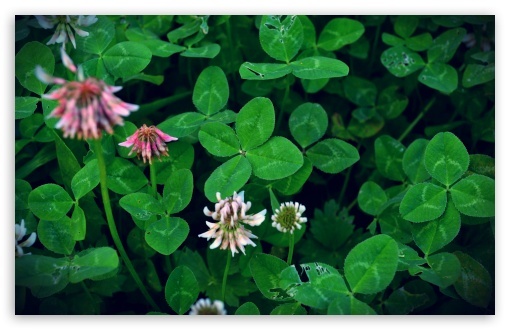 ”Recently I was visiting with a relative who has a two-year-old baby girl, and we were looking for four-leaf clovers. So here I was, a 24-year-old man on my hands and knees, combing through the grass and screaming, “over here I found one”. Actually we found several and I think we were probably more excited than the kid. See children have a way of doing that to you. Through them you can vicariously relive your childhood. In the name of “playing with the kids” you can shed your inhibitions and do the things you used to take for granted. You look at the world through a different set of eyes. It alters your worldview. In the course of reflecting on my four-leaf clover (of course, I kept one) I began to think of all the things you used to do as a kid, and how everything holds wonder and magic for children.“
”Recently I was visiting with a relative who has a two-year-old baby girl, and we were looking for four-leaf clovers. So here I was, a 24-year-old man on my hands and knees, combing through the grass and screaming, “over here I found one”. Actually we found several and I think we were probably more excited than the kid. See children have a way of doing that to you. Through them you can vicariously relive your childhood. In the name of “playing with the kids” you can shed your inhibitions and do the things you used to take for granted. You look at the world through a different set of eyes. It alters your worldview. In the course of reflecting on my four-leaf clover (of course, I kept one) I began to think of all the things you used to do as a kid, and how everything holds wonder and magic for children.“
Episodic Memory, Introspection, and Empathy
These two reports also show that the more vivid retrieval of a past episode in one’s life during a marijuana high often brings back not just the episode as such, but also our personal stance and feelings at the time. Enhanced episodic memory during a high could be at least a partial explanation as to why many marijuana users report introspective, as well as empathic, insights into others. If you have better access to the person you used to be in various phases of your life, you will have a better understanding of how you became who you are now – which aspects of you have changed, where you have made progress, and where you have not. And if you remember better how you felt as a kid, you will have more understanding of children and their needs, fears and hopes, from their perspective.
Our episodic memory is crucial in its functioning for introspection and empathy, but also for many other kinds of cognitive activities. The phenomenon of enhanced episodic memory during a marijuana high has been reported so often by users for centuries that it definitely deserves a closer look from psychologists and cognitive scientists.
We now know that our episodic memory relies on activities in the frontal cortex and the hippocampus. Both regions of the brain contain cannabinoid receptors that belong to an endocannabinoid signaling system and also react to the consumption of THC. So far, however, we do not know if there is any kind of direct way in which marijuana consumption enhances episodic memory retrieval and recollection, or if this is an indirect effect. An indirect route could be that a high usually leads to a hyperfocus of attention – this is what I believe to be one of the most basic effects of marijuana – which may lead to a more vivid and intense recollection of an episodic memory on which we focus.
I think it should be obvious that research concerning marijuana and the often observed enhancement of episodic memory will not only pay off for those interested in marijuana, but could actually deliver highly relevant facts about the nature of episodic memory itself, including the possible involvement of the endocannabinoid system.
Flaubert’s Reminder
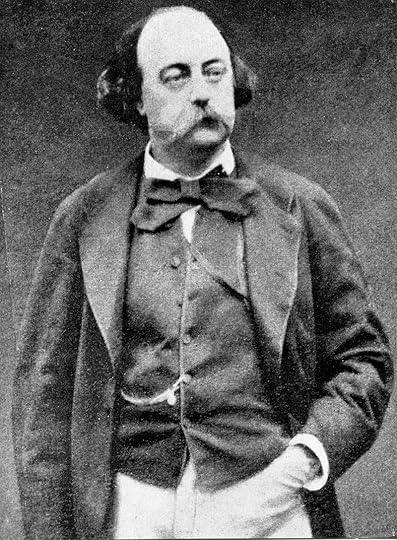
Marijuana user Gustave Flaubert (1821-1880)
The French writer Charles Baudelaire wrote his book “The Artificial Paradises” based on his experiences with marijuana and other substances. When he sent his manuscript to his friend Gustave Flaubert (author of “Madame Bovary”) in 1860, Baudelaire received a very warm and admiring response about the many brilliant observations in it. Flaubert had also participated in some meetings in Paris of the “Club of the Hasheesh Eaters” (“Club des Hashishins”), of which Baudelaire was a member. Beside his overall praise for Baudelaire’s observations, Flaubert remarked:
“It seems to me that concerning this subject field, (…) in a work which is the beginning of a science, in a work of scientific observation and inductive reasoning, you emphasize too much (at various places) the spirit of evil. One can feel here and there the sour influence of Catholicism.”
Maybe scientists and politicians today need to overcome the “sour” influence of the flawed thinking behind marijuana prohibition in order to invest in research that could help so many of us to better understand its temporary enhancing effects on episodic memory.
Yawger, N.S. (1938). “Marijuana: Our New Addiction.” American Med. Sci.,195, p. 353.
Gustave Flaubert in a letter to Charles Baudelaire in 1860, in: Müller, Ulf, and Zöllner, Michael, (ed.) (2002) Der Haschisch Club. Ein literarischer Drogentrip, Tropen Verlag Stuttgart.
The post Marijuana and the Enhancement of Episodic Memory appeared first on High Perspectives.
June 12, 2015
Marijuana, Dopes, and Cognitive Enhancements
When genius mathematician and originator of cybernetics Norbert Wiener moved with his family from Cambridge to Newton, his wife organized the move and let Wiener concentrate on his work as a professor at MIT. She knew her notoriously absent-minded husband would be of no help to her. She also knew he would forget they had moved so she gave him a piece of paper with the new address of their home. Later during his work, Wiener spontaneously came up with an insight, found the piece of paper in his pocket, scribbled down the idea, but then, finding an error in his workings, threw away the piece of paper. In the evening he drove home to his old address and soon realized that he did not live there anymore. The note in his pocket was gone. Wiener had no clue anymore where he lived, so he asked a little girl on the street: “Excuse me, perhaps you know me. I’m Norbert Wiener and we’ve just moved. Would you know where we’ve moved to?” The young girl replied, “Yes, Daddy. Mommy thought you would forget.”
The “absent-minded professor”-phenomenon has long become a stereotype and a popular character in countless comedies.
We basically know what happens when an academic genius like Wiener shows this kind of absent mindedness. Wiener’s attention was probably often so bound to thinking about current mathematical or other ideas or problems that there was not much ‘processing speed’ left for navigating in the real world.

Norbert Wiener, American mathematician and philosopher (1894 – 1964)
We can assume then, that Wiener’s ‘dopey’ behavior resulted from an intense process of concentrated thinking. Wiener’s ‘dopey’ behavior does not show that he is stupid; it only shows that some of his cognitive abilities – like his spatio-temporal orientation – suffer because some other cognitive processes are extremely active and enhanced.
We don’t have to look at geniuses to learn this lesson. When you are really focused on upcoming exams you might run out the house with your shirt buttoned up the wrong way or wearing an odd pair of socks. The intensification of one cognitive process often leads to weakening of others. We all know this from our everyday lives; it seems almost trivial to point this out, but we tend to forget this when it comes to the discussion of psychoactive substances and their effects on cognition. And as trivial as the lesson seems, it is an important one for users and scientists alike, as I will explain now.
Cognitive Enhancements
For thousands of years, marijuana users have reported in detail various forms of what we would now call cognitive enhancements. Some have used the marijuana high to hyper focus their attention, to better attend to perceptions, memories, thoughts or imaginations. Other users have observed that their minds are racing during a high, they feel they can think faster, associatively flying through thoughts, imaginations, or memories. Many value the marijuana high for retrieving distant memories from their past, episodic memories which often come in such astonishing detail that they feel as if they are being transported into the past. We have numerous reports of the enhancement of pattern recognition, where marijuana users describe how they suddenly discover new patterns during a high; patterns in a taste experience, in the behavior of other people, in art, in music, or in nature. Many users have also reported that they become more creative, that their ability for introspection and empathic understanding becomes enhanced or that they can generate great insights during a high.
As we all know, most of these cognitive enhancements can only be experienced given the right “set and setting”. Also, the dosage must be appropriate and the user has to know how to “ride a high”, which is an ability that involves theoretical knowledge as well as some skills. Importantly, this knowledge on the side of the user will involve knowing for which activity marijuana can be best used. This latter point becomes more obvious when we look at the downside of the enhancement of some cognitive abilities.
The Downsides
Of course, there are discussions even between users if marijuana can really enhance our cognition temporarily in those ways. In my book High. Insights on Marijuana, I have tried to show that under favorable conditions a marijuana high can in fact lead to all those enhancements. One thing seems obvious though, these enhancements are never a complete enhancement of all of our cognitive abilities. Just as in real life, the intensification or enhancement of one cognitive ability usually comes at the cost of the worsening or slowing down of others. Here are three examples for some cognitive enhancements during a high and their downsides.
First, ‘mind-racing’ during a high allows a cannabis user to quickly travel through memories, imaginations or chains of thought. Certainly, this enhancement can be used for many purposes; but in my view, it might also contribute to the infamous short-term memory disruptions. So far, the following is only a hypothesis, but I believe that mind-racing might actually be one of the reasons why we are loosing the thread during a conversation when we are high. In sports photography, if you take many photos in a quick succession, your chip shuts down for some moments at a certain point – it needs to take a break to process and store the large amounts of data. Likewise, fast associative thinking might lead to working memory disruptions, where you actually forget at some stage what the point of your story was.
Second, hyper-focusing during a high can intensify whatever comes within the focus of your attention and allows, for example, an enhanced analytic perception and understanding of the complex structure of a Miles Davies trumpet solo. On the other hand, the reinforcement of what cognitive scientists call “selective attention” during a high might make you act “dopey” like Norbert Wiener, causing you to phase out real world navigation tasks.

Gauguin painting Annah the Javahnese (1893)
Third, many marijuana users have observed that during a high their ability to perceive patterns is enhanced. Some see new patterns in art (“I suddenly understood the influence of Paul Gauguin’s work on Vincent Van Gogh”) or in the behavior of their friends. However, a marijuana high might lead to pattern over-interpretation, where we “see” faces in mountain tops or clouds. This may be useful for many purposes, but it might sometimes lead to misinterpretations of what is really out there.
The enhancement of pattern recognition is a “two edged sword”, as Charles Tart observes:
“The patterns that are formed from visual data are organized into a degree of complexity and familiarity that is optimal for surviving in the world around us. Detecting a potential predator concealed in some bushes has survival value; seeing a potential predator in every ambiguous visual input is not conductive to survival of the organism. Thus we may conceive of some optical level (…) of pattern-making activity, of organization of ambiguous (and not so ambiguous) visual data into meaningful concepts. Raise this level too high and we have illusion and hallucination. Lower this level too much and we have stupidity. Marijuana seems to raise this level a fair amount, more so with increasing levels of intoxication.“
In brief, then, we can see that cognitive enhancements coming from a marijuana high usually lead to the weakening of other cognitive processes, just as we might expect it from our everyday lives. As trivial as this insight might seem, it has important implications both for marijuana users as well as for scientists.
Lessons to be learned
If used under favorable conditions, a marijuana high can lead to significant enhancements of specific cognitive functions and abilities. But these usually bring with them the weakening of specific other functions. Users have to learn how various strains can bring respective characteristic cognitive enhancements but also a temporary slowdown or other negative effects upon other cognitive functions. They have to learn for which specific activities to use a certain strain so that they can get the best out of the overall cognitive alterations deriving from its respective high.
Scientists should be careful with the implications of their studies when it comes to the evaluation of the effects of marijuana on cognition. If you only look for negative effects on cognition in specific situations (like, for example, performance in multitasking, various standard short-term memory tests, etc.), you will certainly find nothing else. We know that after decades of irrational prohibition, scientists were encouraged to obtain such conclusions. That’s what they usually get paid for. Some of these tests may show that some cognitive functions during a high are disrupted or weakened in various situations. Yet, that does not imply that the reports of hundreds of marijuana users and their positive cognitive enhancements are wrong. Norbert Wiener might have been habitually bad at orientation, but that does not contradict the fact that the highly concentrated thinking and the resulting ideas causing his “silly” behavior were pretty stunning.
Marincolo, Sebastián (2010), High. Insights on Marijuana. Dog Ear Publishing, Indiana.
Tart, Charles T. (1971) On Being Stoned: A Psychological Study of Marijuana Intoxication. Palo Alto, Cal.: Science and Behavior Books, p. 59.
The post Marijuana, Dopes, and Cognitive Enhancements appeared first on High Perspectives.
May 22, 2015
Marijuana and The Power of Imagination
„Logic will take you from A to B. Imagination will take you everywhere.“
Albert Einstein
The Underestimated Value of Imagination
When we think about our capacity for imagination, we often think of it as a kind of visual daydreaming – a handy ability utilized mainly by artists and other creative people. We tend to underestimate how crucial our use of imagination is in our everyday lives. In fact, we rely on your imagination all of the time – not only when we think creatively, but also when we make decisions. You may decide not to go skiing next week because you heard the bad weather forecast and imagine it to be very cold and nasty in the mountains. Anticipating the cold wind up there in the mountains, you can literally feel a shiver going down your spine. As this example shows you do not only visually “picture” situations in your mind when you use your imagination; you also imagine sounds, tastes, smells, feelings or moods. In his seminal book Human. The Science Behind What Makes Us Unique, neuroscientist Michael Gazzaniga reminds us how powerful a role imagination plays in our lives:
“Imagination also allows us to time travel. We can go in the future and back to the past. An event may be long in the past, but I can replay it in my imagination from memory. (…) Likewise, I can project in the future. I can use my past experience of an emotion and apply it to future circumstances. I can imagine how I would feel, for example standing at the open aircraft door with a parachute on my back (terror, which I have felt in the past and did not enjoy) and decide I can bypass this adventure.”

Would you jump out of a plane with a parachute? Your imagination is crucially important for decision making.
Of course, there are more important decisions in life than those about whether we want to go skiing or jump out of a plane. When we make decisions about whether or not to marry our beloved partner, we might go through several processes of imagination: “Can I see us getting along also in times of a crisis? Do I enjoy the thought of having her by my side as a mother of our children? Will she still make me a better person in 20 years?”
It is easy to see how the capacity for imagination leads to an evolutionary advantage, as the neuroscientist Vilayanur Ramachandran observes:
“When you imagine something – as when you are rehearsing a forthcoming bison hunt or amorous encounter – many of the same brain circuits are activated as when you really do something. This allows you to practice scenarios in an internal simulation without incurring the energy cost or risk of a real rehearsal.“
Imagination is not just a nice-to-have ability mostly developed in creative professionals: we all heavily rely on our imaginative capabilities every day. Our imaginative abilities have a fundamental impact on the way we all make decisions in our lives.
The Enhancement of Imagination During a High
It is important to be reminded of the importance of imagination to understand the importance of the enhancement of imagination during a marijuana high. Many users of marijuana have reported a more vivid imagination when reading or thinking about a situation. When Harvard professor Charles Tart sent out questionnaires for his psychological study On Being Stoned, many users of marijuana endorsed the following statements for moderate levels of a marijuana high:
“If I try to visualize something, I see it in my mind’s eye more intensely, more sharply than when straight.“ (…)
“If I try to have an auditory image, hear something in my mind, remember a sound, it is more vivid than when straight.“ (…)
“If I try to imagine what something tastes like, I can do so very vividly.“
“I can experience vivid tactual imagery, imagine what things feel like and feel their texture very vividly in my mind“
As a concrete example, here is a report from a mandolin player in a bluegrass group, who writes that he likes to practice playing high: 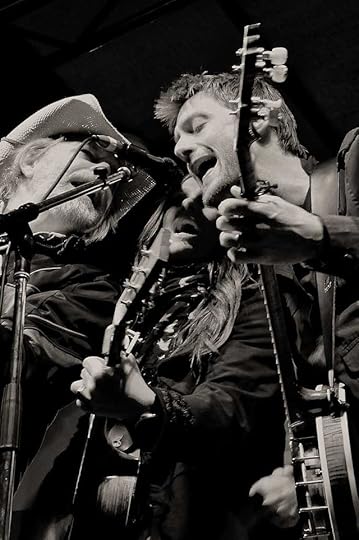
”I might smoke before playing. I play in a group, and I’ll sit down and do a couple of hits to put a little edge on while I’m playing. When I’m stoned, I can visualize musical relationships more easily. The other day, I was practicing scales on the mandolin, double lines of scales in intervals. Playing them high, I made more sense out of them, and finally understood when and how they might be useful in my playing.“
Why don’t we connect the dots?
Many marijuana users have experienced several enhancements of imagination themselves and have described how they use these enhancements. Some have reported that they can better visualize objects or faces and use this in their artwork; musicians feel that they can better imagine how various instruments work together and use this for musical compositions, whereas other like to get high and start cooking, using the enhancement of their imagination to come up with new ideas for food compositions, imagining how certain spices or herbs would taste with certain vegetables.
I believe that most marijuana users have experienced the enhancement of imagination during a high in some form, but underestimate the incredible cognitive potential of this effect. Why don’t they connect the dots?
There are several reasons why we tend to underestimate the potential of this imaginary enhancement. First, a still ongoing disinformation campaign that has lasted for decades has led us to focus on the risks of marijuana instead of looking at its potential (and many of the risks, as we now know, have been invented by spin doctors). Second, we tend to look at the process of imagination as a sort of conscious daydreaming and forget that we also rely on it unconsciously way more often in our everyday thinking. Third, we usually consider imagination only as visual imagination; but as stated above, imagination is much more than that. Fourth, we tend to think more of other psychoactive substances like LSD or psilopsybin when it comes to enhanced imagery and imagination, because these substances bring full-blown visual trips.
Once we understand that marijuana has the potential to enhance our imagination, not to mention how important imagination is to our cognition in general, we can better understand the many reports of scientists, artists, writers and other people who have used this enhancement for various purposes.
Scientists have often described how their imagination helped them to come to solutions to problems and great ideas. One of Einstein’s greatest insights came when he imagined what it would be like to ride on a beam of light, while the chemist Friedrich August Kekulé von Stradonitz saw the Benzedrine ring in a reverie of a snake biting its tail. The designer Philip Stark reported in an interview how he actively uses his dreams to better imagine and visualize new designs in 3D.
Naturally, a marijuana high alone will not turn you into an Einstein, a Kekulé, or a Philip Stark. But it may help you to better imagine situations, objects, smells, sounds, tastes or tactile sensations. If you are able to “ride your high“ and to use this enhancement, it could help you with important decisions, to vividly remember crucial events in your life, or to come up with life changing ideas.
Enhanced imagination and politics
The German philosopher Ernst Bloch participated in hashish experiments with his friend Walter Benjamin in 1928 and later praised the value of enhanced imagination during a hashish high in his central work “The Principle of Hope”, written between 1938-47. He compares the state of a cannabis high to that of a waking dream and emphasizes that this altered state of mind allows us to think clearly and to profit from the experience:
“(…) opium seems to be more associated with the dream of the night, whereas hashish seems associated to the freely wandering, swarming daydream. Also, during hashish intoxication the ego is hardly altered, neither its individual nature nor its reasoning ability are taken away (…) Modern experimenters have characterized Hashish dreams as of an enchanting lightness (…), in short, for the talented hashish dreamer, the world becomes a request concert.” (…) “Furthermore, hashish intoxication does not lack another kind of lightness: ‘the individual believes to see his plans disentangled and to move towards their realization, plans which seemed impossible to clarify so far.”
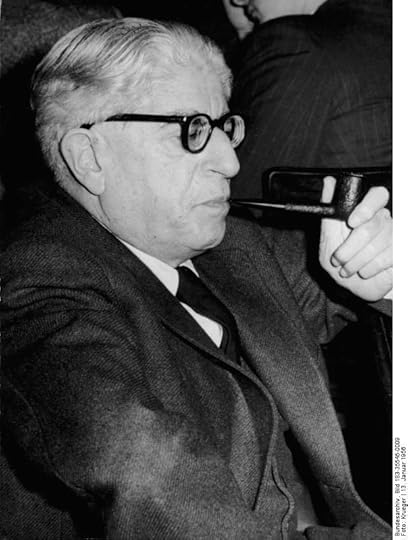
Philosopher Ernst Bloch, 1885-1977
Bloch, usually considered as a neo-Marxist thinker, emphasized that humans are far more than simply the product of their environment and upbringing. His philosophy is based on an image of human as essentially striving to think ahead and to imaginatively work on a utopia. He would later become a vastly influential professor for philosophy at the University of Tübingen – where I would later study philosophy – and became friends with Rudi Dutschke, both of whom would later be considered as leading figures in the 1968 student revolution in Germany. Bloch clearly saw the positive social and political dimension of this state of daydreaming induced by hashish:
“Daydreams have no censure whatsoever from a moralistic Ego, as we can see it in the dreams of the night: their overreaching utopian Ego builds itself and its own as a cloud-castle in an astonishing unburdened blue.(…) The Self of the daydream can become so wide, that it also stands for others: (…) The sleeper is alone with his treasures, the Ego of the daydreamer can extend to others. If the Self (is) not introverted anymore or just related to its immediate environment, then its daydream seeks to improve public matters.”
Ernst Bloch’s “The Principle of Hope” first appeared in 1954 and became a set text for many in the beat generation, decades before they started to daydream inspired by the use of cannabis.
In 1972, marijuana user John Lennon, who had been turned on cannabis by Bob Dylan in New York some years before, almost got deported back to the UK for having been caught with marijuana. Lester Grinspoon, who testified for Lennon during the legal process, recounts how he sat down for dinner with Lennon and Yoko Ono:
“I told John how cannabis helped me to hear his music for the first time in much the same way that Allen Ginsberg had seen Cezanne for the first time after he smoked cannabis before going to the Museum of Modern Art, to determine if marijuana could help him break through his incapacity to relate to Cezanne. It did.
John replied that I had experienced only one facet of what marijuana could do for music. He said that it also enhanced the ability for composing and making music.”
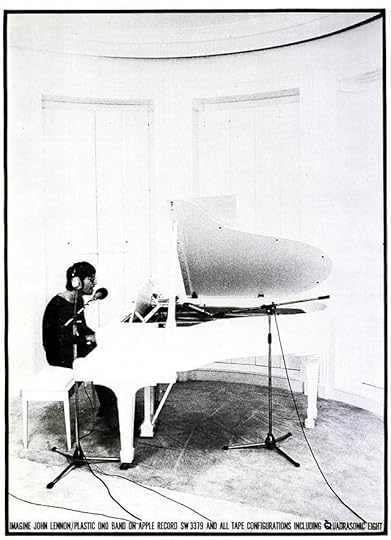
John Lennon in an advertisement for his album “Imagine”
Shortly before the deportation hearings, Lennon had expressed his daydreams in his song “Imagine”– the song that would later become one of the hymns of the peace movement:
Imagine there’s no countries
It isn’t hard to do
Nothing to kill or die for
And no religion, too
Imagine all the people
Living life in peace
You, you may say I’m a dreamer
But I’m not the only one
I hope someday you will join us
And the world will be as one.
Novak, William (1980) High Culture. Marijuana in the Lives of Americans, The Cannabis Institute of America, Massachusetts, p. 52.
Lewin, Louis (1927), Phantastica. Die betäubenden und erregenden Genußmittel – für Ärzte und Nichtärzte, p. 159 ff.
Bloch, Ernst (1959), Das Prinzip Hoffnung, Suhrkamp Verlag, Frankfurt p. 100.
Ibid., p. 101.
“Brady, Pete” (2001), “Lester Grinspoon: Defending Medical Marijuana,” Cannabis Culture Magazine, http://www.cannabisculture.com/articl...
The post Marijuana and The Power of Imagination appeared first on High Perspectives.
May 11, 2015
Marijuana and Creativity – A Love Story
“O! For a muse of fire, that would ascend the brightest heaven of invention.”
William Shakespeare (1564-1616)
In a good relationship, a loving partner can inspire you in many ways. She (or he) may simple inspire you day-by-day with their beautiful smile, encourage you to compose your music or help you to relax and refresh your energy. Your beloved partner could also help you to discipline yourself, to keep focussed on a writing a book, drag you to a movie she finds interesting for you to help collecting ideas for a movie project, or provide valuable feedback during the creation process of your new musical composition. There are many ways a lover can help your creative output.
Naturally, things can also go wrong. Your partner may also negatively influence you or completely block your creative output in just as many ways. He or she could distract your attention away from your project, undermine your self-esteem or keep you constantly busy with irrelevant problems.
Marijuana can be to your creativity like a loving partner; a muse, inspiration and a help in many ways. But like a partner, it can also interfere negatively with your creative output in many ways when things go wrong in your relationship.
Does marijuana “enhance creativity”? The short answer is that marijuana certainly has a magnificent potential to do so. However, that does not mean that marijuana automatically pushes a “creative boost button”, for a simple reason; there is no such button. Creativity is not like electricity or a mysterious energy. It is the product of a successful concentration of various highly complex cognitive skills – and often crucially involves an additional concentration of many physical skills. This basic fact is often overseen in discussions when it comes to marijuana and creativity – not only by laymen, but also by scientists. The marijuana high affects various cognitive processes that are part of the creative process. If we want to know how marijuana can enhance creativity, we have to look at a variety of cognitive alterations during a marijuana high and analyze how these can be either helpful or, otherwise, detrimental for a creative activity.
A Variety of Creative Processes, Phases, and Cannabis Strains
The story gets even more interesting, though, when we look at a variety of creative processes. Playing a new drum solo in a band during a live performance demands the coordination of various cognitive abilities and, simultaneously, flawless hand-eye coordination.

Gene Krupa, legendary jazz drummer and marijuana user
These abilities are very different from those a poet needs when he silently sits down trying to write a poem about the sound of wind going through a field of rye. For the spontaneous exploration of dance, a solo dancer requires the perfect functioning motor control of his whole body, timing and an ongoing stream of ideas in how to transpose music into motion. Marijuana can indeed help artists, musicians and others by a multitude of cognitive alterations that enhance a whole variety of cognitive processes. But we shouldn’t expect this to be a simple relationship. The many alterations of cognitive processes during a marijuana high have a different impact on various creative processes. Moreover, there are not only vastly different creative processes, but also, creative processes come in different phases. In his book High. Marijuana in the Lives of Americans, William Novak quotes an essayist stating:
“I just can’t write well on grass. My grammar and syntax get screwed up, and I can get caught in the details. I do some of my thinking stoned, and the more linear work is done straight.”
If you want to use marijuana for creative purposes you will have to find out whether marijuana can help you for a certain creative process during a certain phase. As more advanced marijuana users know, this will also depend on the type and strain of cannabis you are using. Often, we forget another crucial aspect at this point; whether marijuana can help you for a certain creative process also crucially depends on your own psychological makeup. While a person with Obsessive Compulsive Disorder (OCD) may appreciate that cannabis helps him loosen up a bit and to break with routines, a user with a tendency for ADHS (Attention Deficit Hyperactivity Syndrome) might appreciate the fact that certain strains can calm him down and help to focus his attention better. Others may find such relaxation effects as being counterproductive for their work. In an interview with HIGH TIMES Magazine, essayist Susan Sontag once said that for writing, marijuana would relax her too much – she said she preferred a little speed once in a while. Other writers feel they can write perfectly during a high because they feel more concentrated and have a better flow while writing.
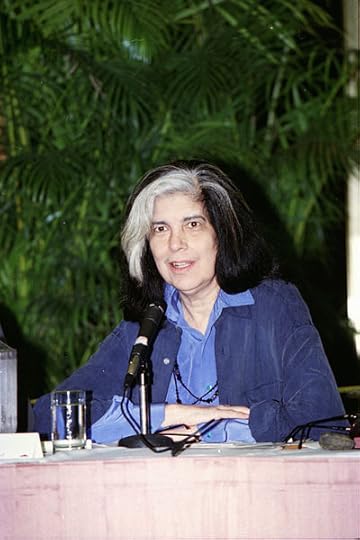
Essayist and writer Susan Sonntag, 1933-20014
In what follows, I will name a few effects of marijuana and outline how they might impact creativity; the list is not supposed to be complete. My intention is to broaden the perspective of many researchers in the field who have tried to reduce the “creativity-boosting” power of marijuana to one or two effects that have been confirmed in psychological studies (as for instance “hyper-priming”).
The High: A Variety of Cognitive and Perceptual Alterations
The taste of marijuana has often been underestimated because it is considered a “weed” and a “drug”, and because it is often used in the wrong way mixed with bad tobacco. Use a well-grown, great tasting strain in a vaporizer and you will experience the obvious: marijuana has a complex herbal, nutty, fruity, earthy, delicate taste. Similarly, the effects of marijuana are usually underestimated as just bringing a euphoric “high”, relaxation, and something like a better associative flow in thinking. The story, however, just like with taste, is much more complex – and much more interesting.
Based on the analysis of hundreds of reports of marijuana users and studies thereof I have described several cognitive and perceptual alterations during a high leading to various enhancements in my study High. Insights on Marijuana. The study aims to explain how these alterations can lead to creative insights. During a high, users experience a hyperfocused attention. Sensations of all kinds coming into that focus are not only experienced as more intense, but are also perceived with more detail. The seemingly simple taste of fresh water turns into a highly complex taste experience, with salty, fruity and herbal associations freely floating together in a symphony of delight.
Furthermore, while high the capacity of users to imagine situations is enhanced and they can often vividly recall episodes of their past, sometimes reviving long forgotten memories in astonishing detail. Marijuana users often describe how their mind races quickly through memories, ideas or associations. They report the enhancement for pattern recognition of various kinds during a high; seeing new patterns in an artistic painting style, in the playing style of a jazz musician or in the behavior of friends. Many have used the high for better introspection and have found out important aspects about themselves. Many others have reported an enhanced empathic understanding of others, feeling that they can more easily put themselves “into their moccasins”. Many other users report spontaneous insights during a marihuana high.
Briefly then, the marijuana high brings a variety of mind-alterations which can be positively used – but the successful use of a high for a creative process crucially depends on the knowledge and the ability of a user to choose the right strain under the right circumstances for the a certain phase of a certain creative process.
So, what are the effects of marijuana on cognition which can turn out to be especially helpful for creative processes, and how can they enhance a users creative activity? In the following, I will describe some of the typical cognitive alterations during a high used by artists and other people.
Hyperfocussing, Redirection of Attention, and the Moment of Awe
One of the most fundamental effects of a marijuana high is the often reported hyperfocus of attention; cannabis users concentrate stongly and exclusively on whatever comes into the focus of their attention. This hyperfocus often leads to an intense perception of the here-and-now of existence. Whatever comes into the attentional focus of the user becomes not only more intense, but can often be explored in more detail. Time seems to slow down. The stunning experience of the here-and-now often leads to an exciting feeling of awe and wonder. Often, subjects report that their attention is redirected to aspects of objects or situations they would usually not attend to that much. Suddenly, they do not look at an object anymore under pragmatic aspects – they do not think about the usual ways to use it, but start to explore it’s colors, surfaces or shades from a different perspective, like an artist or a scientist scrutinizing its nature. The Irish poet William Butler Yeats once wrote about his experience during a strong marijuana high in Paris:
“I opened my eyes and looked at some red ornament on the mantel-piece, and at once the room was full of harmonies of red, but when a blue china figure caught my eye the harmonies became blue upon the instant. I was puzzled, for the reds were all there, nothing had changed, but they were no longer important or harmonious; and why had the blues so unimportant but a moment ago become exciting and delightful? Thereupon it struck me that I was seeing like a painter, and that in the course of the evening every one there would change through every kind of artistic perception.”
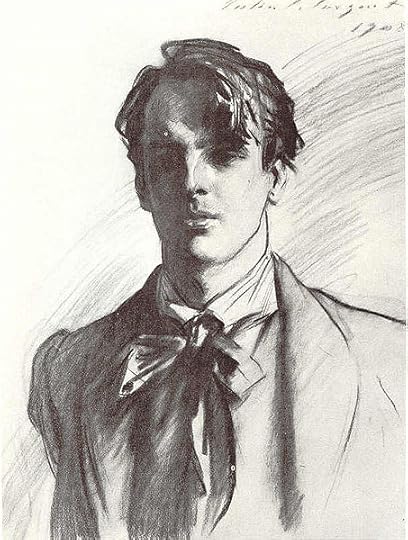
The Irish Poet William Butler Yeats, 1865-1939
For many marijuana users, this feeling of awe and wonder can be a crucial and life-changing catalyst for deeper investigations into patterns they have not explored before. In his essay ”Creativity, Marijuana and a ‘Butterfly Effect in Thought’“, Jason Silva points out the importance of the feeling of wonder induced during a high:
“(…) Marijuana enhances our ability to marvel: In some mysterious and uncannily recurring way, marijuana can induce an almost ‘synesthetic ecstasy,’ whereby a loosening of the usually firm borders that separate our five senses allows for a broader, deeper, more profound, and often time-dilated “interpretation” and “internalization” of moment-to-moment experience.”
Synesthesia, Pattern Recognition and Metaphors
Silva mentions the effect of synesthesia. Marijuana users experience full-blown synesthetic effects like seeing colors while listening to a guitar solo only for higher doses of marijuana. I have argued before that a pre-synesthetic effect of marijuana occurring even at lower doses may be constitutive for creative enhancements, leading to what I have called an enhanced ability for “isomorphism extraction”. In other words, the high seems to enhance our ability to extract similarities between seemingly unrelated concepts, objects, processes or patterns. The process of pattern recognition itself always involves the extraction of a similarity; when you look at a painting that you have never seen before and you recognize it as by Edgar Degas, you extract a similarity between the painting you are looking at and other Degas paintings works you have seen in the past; you re-cognize the style on the basis of an isomorphism extraction, a cognitive process to find similarities.
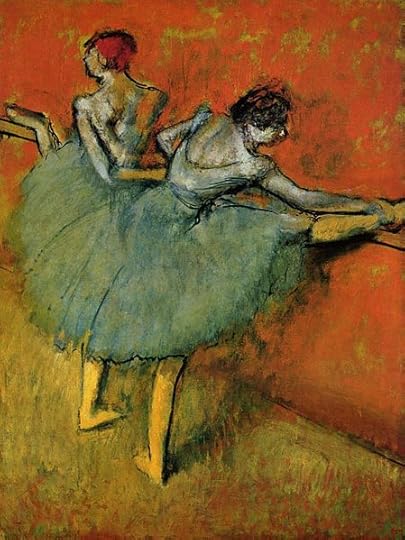
Edgar Degas (1834-197): Dancers at The Bar, 1888, The Phillips Collection, Washington, D.C.
Many reports from marijuana users show that during a high, they attend to different aspects of situations, objects or behaviors and discover new patterns. Suddenly they link seemingly unrelated structures, processes or concepts a process that is crucial for the invention of new metaphors. Obviously, this is one of the fundamental effects of marijuana used by creative people in many areas.
Enhanced Imagination
There are countless reports of marijuana users regarding vivid imagery during a marijuana high and their enhanced ability for imagination. The effect usually goes undisputed in conversations about marijuana, but it is often overseen how important it is for various cognitive skills and especially for creative purposes. A New York painter reports:
”What I will allow myself to do – and succeed quite well in doing – is to paint mentally while I’m stoned. An image comes to my head, and, I refine it, rearrange it a number of times, and then let it float. The final stage of the image comes back to me, in a flash, later, when I’m straight. I can then use the mental painting as a series of shortcut steps.“
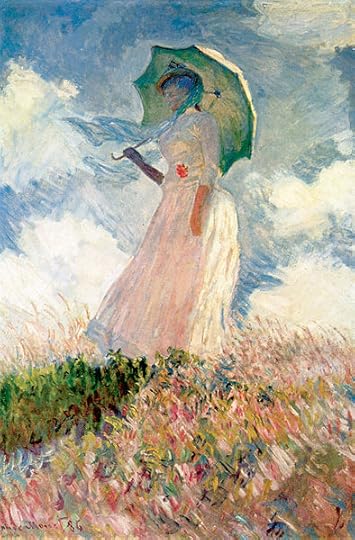
Claude Monet (1840-1926). Study of a Figure Outdoors: Woman with a Parasol 1886
Naturally, imagination is not restricted to the visual area; chefs have reported how they can better imagine the taste of combinations of food during a high, and musicians describe an enhanced ability to imagine melodies played by various instruments, thereby aiding their composing skills.
The Enhancement of Empathic Understanding
Marijuana users often experience an enhancement of their empathic skills during a high. This enhancement is never named in connection with creativity, but I think it can be of fundamental importance when it comes to various creative processes. Writers may feel that they are better able to slip into another personality and to creatively write fiction involving the feelings of their characters. Generally, an enhanced ability to see the world through the eyes of others can be of tremendous help when attempting to come up with new perspectives and ideas.
Marijuana and Creativity: A New Approach
Let me conclude with some remarks about existing research on marijuana and creativity. Many studies on marijuana and creativity will have to be critically re-evaluated. Scientists usually work with neophyte test subjects who do not necessarily know how to use marijuana correctly for the purpose of creative enhancements. Yet, as argued above, refined knowledge and experience with marijuana is crucial for a user to profit from various cognitive alterations during a high. Also, many studies focus on a simplified and abstract definition of creativity. I have argued here that the cognitive skills involved in creativity can vary significantly given the diversity of creative processes. Future research should better be directed at finding out about the basic cognitive effects of various cannabinoids and then investigate how these can influence a diversity of creative activities under favorable circumstances – ranging from an improvised trumpet solo to the writing of a poem.
Novak, William (1980). High Culture: Marijuana in the Lives of Americans. Massachusetts: The Cannabis Institute of America, Inc, p. 138.
Interview with Susan Sontag in the HIGH TIMES, March 1978, #31.
Marincolo, Sebastián (2010) High. Insights on Marijuana. Dogear Publishing, Indianapolis, USA 2010.
William Butler Yeats (1906) Discoveries, chapter „Concerning Saints and Artists“ (quotation taken from veryimportantpotheads.com).
http://realitysandwich.com/113157/marijuana_effect/, 2012
Compare Marincolo, Sebastián (2010), High. Insights on Marijuana. Dogear Publishing, Indiana, USA. My argument is based on the groundbreaking work of the neuroscientists Vilayanur Ramachandran and Edward Hubbard.
The effect of semantic hyperpriming is presumably based to the pre-synesthetic effect described. Hyperpriming is a process in which subjects make unpredictable connections between items – a much-discussed recent study has shown that marijuana can induce a state of hyperpriming in subjects. See Morgan, CJA; Rothwell, E; Atkinson, H; Mason, O; Curran, HV; (2010), “Hyper-priming in cannabis users: A naturalistic study of the effects of cannabis on semantic memory function”, Psychiatry Res, 176 (2-3) 213 – 218.
William Novak (1980), „High Culture. Marijuana in the Lives of Americans“, The Cannabis Institute of America, Massachussetts, p. 131.
The post Marijuana and Creativity – A Love Story appeared first on High Perspectives.
High Perspectives
- Sebastian Marincolo's profile
- 14 followers


